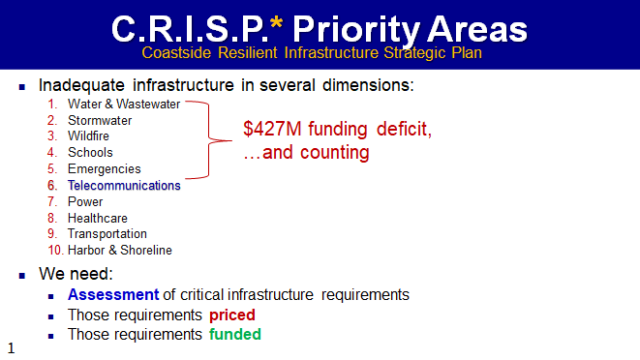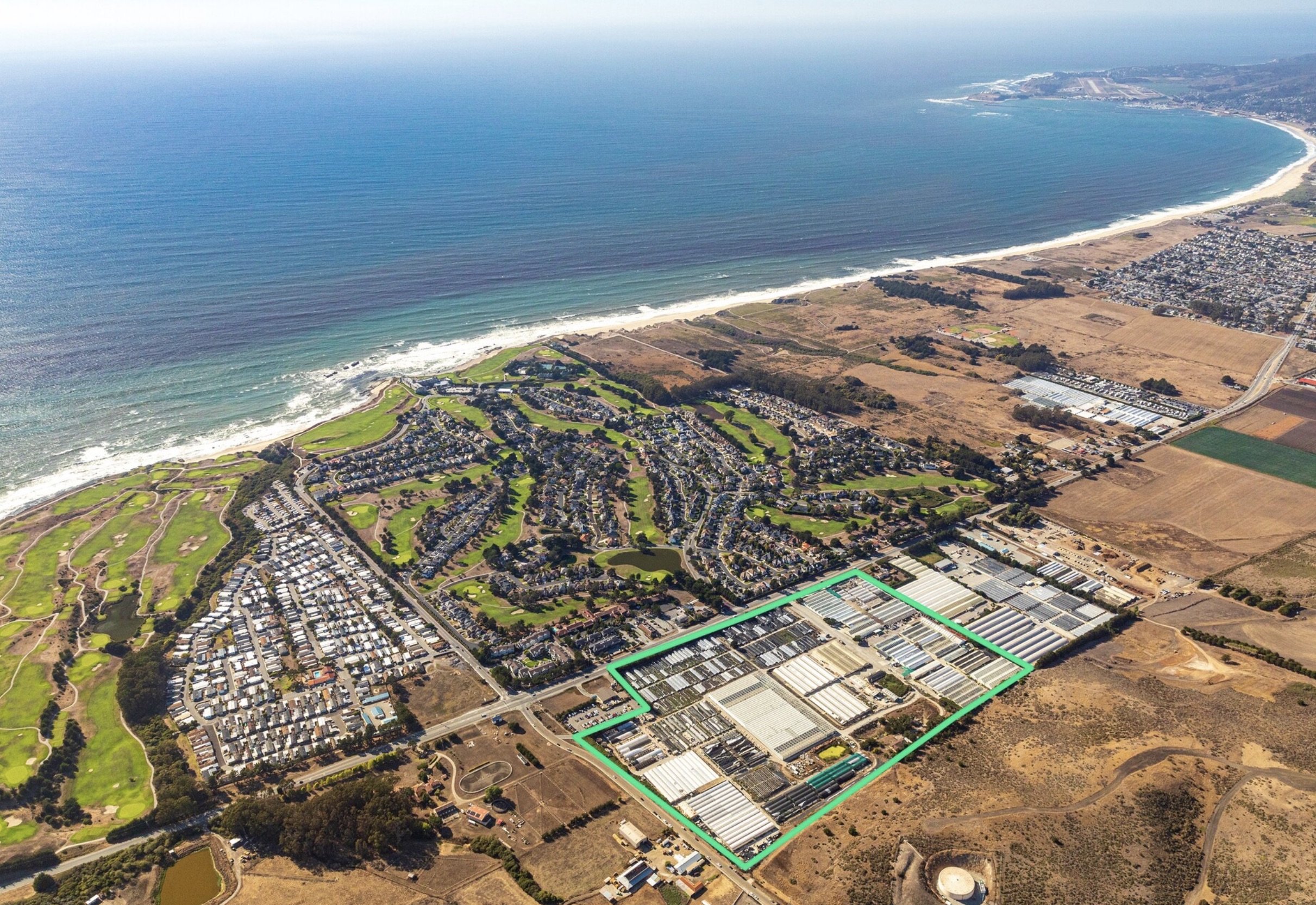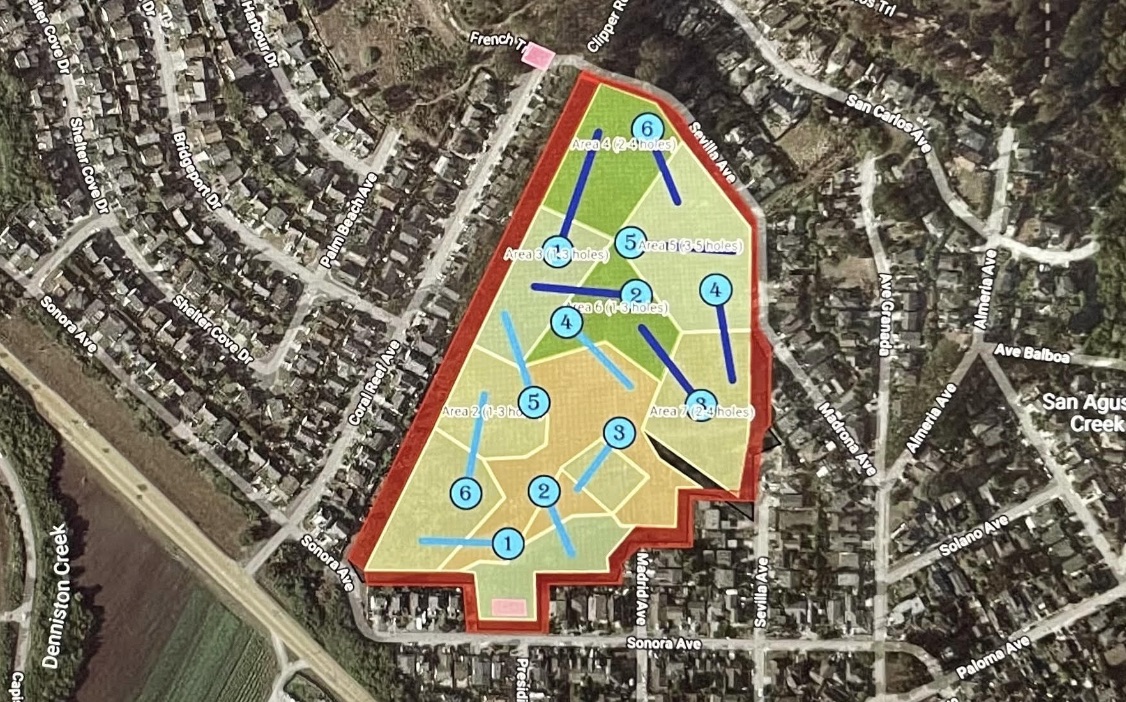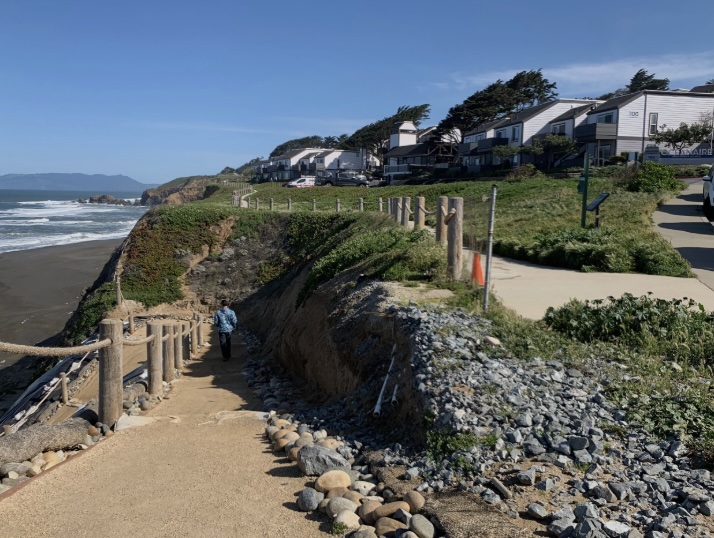|
Getting your Trinity Audio player ready...
|

OWN VOICE. ~ InPerspective by Gregg Dieguez —
Ray Mueller pulled more than a rabbit out of his hat on June 15th; he got $200,000 from the San Mateo Emergency Services Council to fund the San Mateo County Coastal Resilient Infrastructure Strategic Plan (CRISP). That money will fund the development of a priority list of infrastructure needs. You may think this effort was driven by our dire experiences with flooding, trees crushing homes, power and communications failing, our evacuation route being blocked, and the sewer plant almost failing in the Dec 31/Jan 1 and subsequent storms. However, Supervisor Mueller’s idea for this plan existed well before that, when we finalized the acronym last December 2nd. He has seen this need for some time. By magically finding that funding, he avoided a lot of delay in trying to get funds through the deliberate pace of SMC annual budgeting and Measure K funding.
At that meeting I raised concerns about the scope presented in the staff report, and I will repeat those below. However, at the meeting, with representatives from every city and town in the County, the reception was almost warm to the idea of sending us money. One member said he hadn’t realized how difficult it had been out here. Another praised the emphasis on social justice and vulnerable communities mentioned in the staff report. The toughest questions Ray faced were: “Are you sure $200K is enough money for this plan?” and “Are you going to come back to us for more money later?”, to which Ray answered Yes and No, respectively. But the staff report, IMHO, did not cover three and a half critical issues, and the underlying theme. For me the underlying theme is: “Trying To Prevent The Next Generation Of Homelessness”. Let’s avoid getting people flooded, burned or crushed out of the homes they worked all their lives to pour their energy and savings into. Oh, and preserve the tax base.
Here are the missing ingredients in the staff report:
1. Evacuation:
This is mentioned as part of another study, the “All-Hazard Evacuation Plan” being developed by the Department of Emergency Management, which is why I consider this half an omission. But I would again stress the vulnerability of our only evacuation route, much less than in Paradise (which had 5 roads) while have more types of natural disaster risks. Whichever document covers this topic has to secure our evacuation route, and that includes removing trees near Hwy 1 which could fall and block both first responders and evacuees.
2. Stormwater:
This is one of the central problems Midcoast. It’s behind the flooding at the SAM plant, as well as the more visible trees falling, homes flooding, and roads being blocked. While stormwater infrastructure isn’t really called out in the staff report, the description of infrastructure types and planned adaptation strategies does address stormwater impacts and opportunities. But stormwater needs to be an explicit focus, starting with creation of the missing San Mateo County Stormwater Master Plan. This will be the focus of an upcoming MCC Stormwater Report, telling the stories of several impacted neighborhoods, and the management processes (or lack thereof) which need to be improved.
3. Wildfire:
We’ve covered the huge wildfire risks here in Buzz articles for years: how the Coastside parallels the Oakland Hills fire in our risk situation, but without the evacuation options. Supvr. Horsley got us funding to remove some eucalyptus in El Granada medians, to mixed reception among the residents. He also got us a County Wildfire Coordinator on a temporary grant basis, and after three months, he disappeared from our view without enlightening us as to the wildfire management process in our county. Don also worked with RCD to get a grant for a simulation study of the wildfire risk in the El Granada/Quarry Park area, using state of the art technology to prioritize wildfire mitigation zones, and providing what Kellyx Nelson felt was state of the art justification for grant funding. However: a) the study didn’t include costs, b) the study didn’t include damage estimates with/without mitigation – thus no ROI on the efforts to help prioritize, c) the study didn’t model damage to residences, d) the scope was geographically limited, and e) the study had several questionable assumptions, including the wind data, as pointed out by several members of the Wildfire Warriors. Oh, and finally, I haven’t heard of any progress to ACT on mitigating even the highest priority areas [Wildfire Scoping Study Completed: Now what?]– though Parks has certainly thinned Quarry Park a lot – but QP wasn’t deemed a priority zone any longer because of that clearing work.
What we need in both Stormwater and Wildfire is an explicit county management process, with defined success metrics, ongoing auditing of risks, continually re-planning, resourcing for priority risks, and a sustainable process for funding efforts, and so on. If CRISP does not flag the needs for a Learning Management Process, then we are going to continue to fall behind again and increase the risks to all residents, visitors, oh, and the tax base.
4. Fiscal Sustainability:
Plans are worthless without the resources to action them. To be effective, CRISP must also provide mechanisms to fund the work required. Of course, some of those funding issues stem from fiscal mismanagement of public works – a national problem about which we have written several times. The full dimensions of CRISP are yet to be determined, but I expect it to span from Pacifica to Moonridge, and possibly as far as Pescadero. I took a quick attempt at a list of infrastructure deficiencies this past April, and it came to $427 million. Of course the list was not complete, and just as importantly, it includes things that other entities than the County will have to fund all or part of – for example the reserve deficits in the water and sewer systems.
A word about those reserve deficits: some people found them hard to believe when I published my article on Public Works’ Capital Deficits – How Deep Is The Hole? last year. However, when I reviewed their reserve deficit with the Harbor District, they said I was $10M LOW. And we can see HMB fighting tooth and nail to avoid capital expenses at SAM, and the City has a $12.4 stormwater capital budget… with $10M UNFUNDED. Finally, CCWD just borrowed $7M to replenish a treatment plant, and it wasn’t because of some new regulation or capacity expansion … it was because they hadn’t been reserving enough money for years. So those deficits are rising to the surface, and with Climate Change they will surface soon.
Bottom line: Thanks to Supvr. Mueller for moving us in the right direction with CRISP. Now, let’s get going on the right path.
The complete CRISP staff report is available here.
My bad first draft of CRISP funding needs is available here.
[pdf-embedder url=”https://www.coastsidebuzz.com/wp-content/uploads/2023/06/2023-03-06_CRISPlist.4Buzz.pdf”]
 More From Gregg Dieguez ~ InPerspective
More From Gregg Dieguez ~ InPerspective
Mr. Dieguez is a native San Franciscan, longtime San Mateo County resident, and semi-retired entrepreneur who causes occasional controversy on the Coastside. He is Chair of the MCC, but his opinions here are his own, and not those of the Council. In 2003 he co-founded MIT’s Clean Tech Program here in NorCal, which became MIT’s largest alumni speaker program. He lives in Montara. He loves a productive dialog in search of shared understanding.





